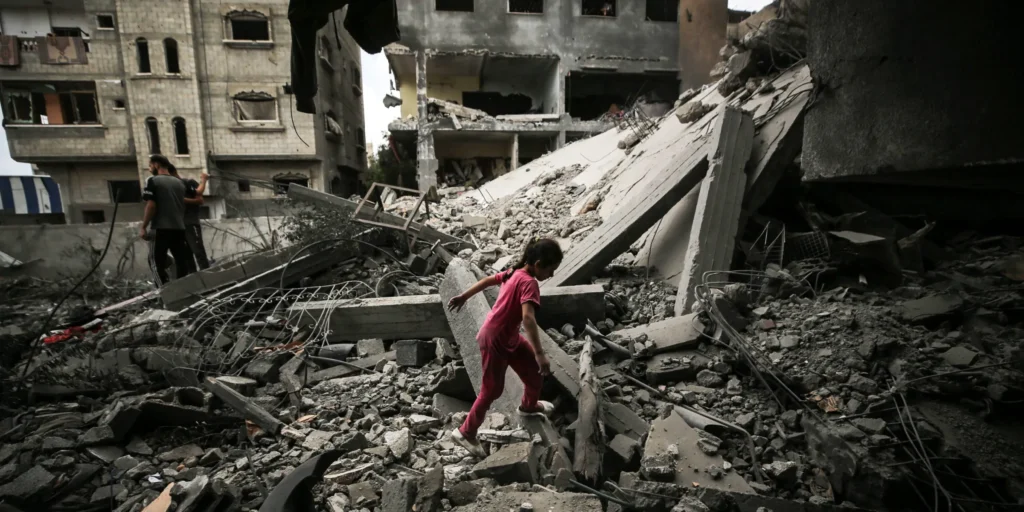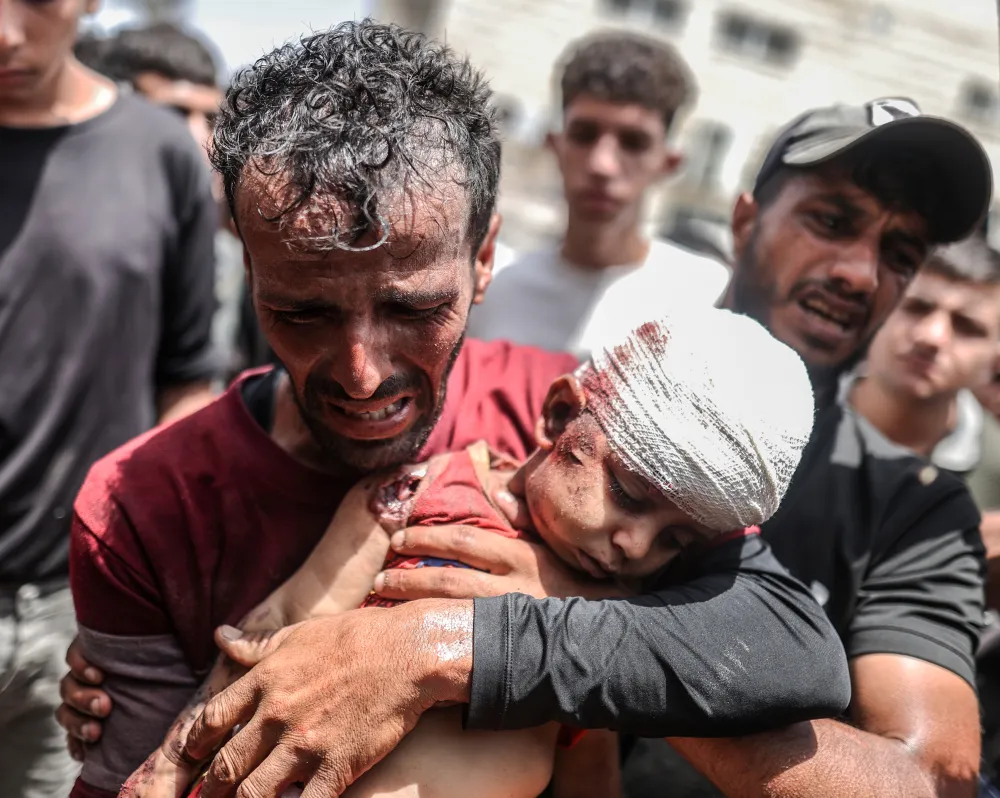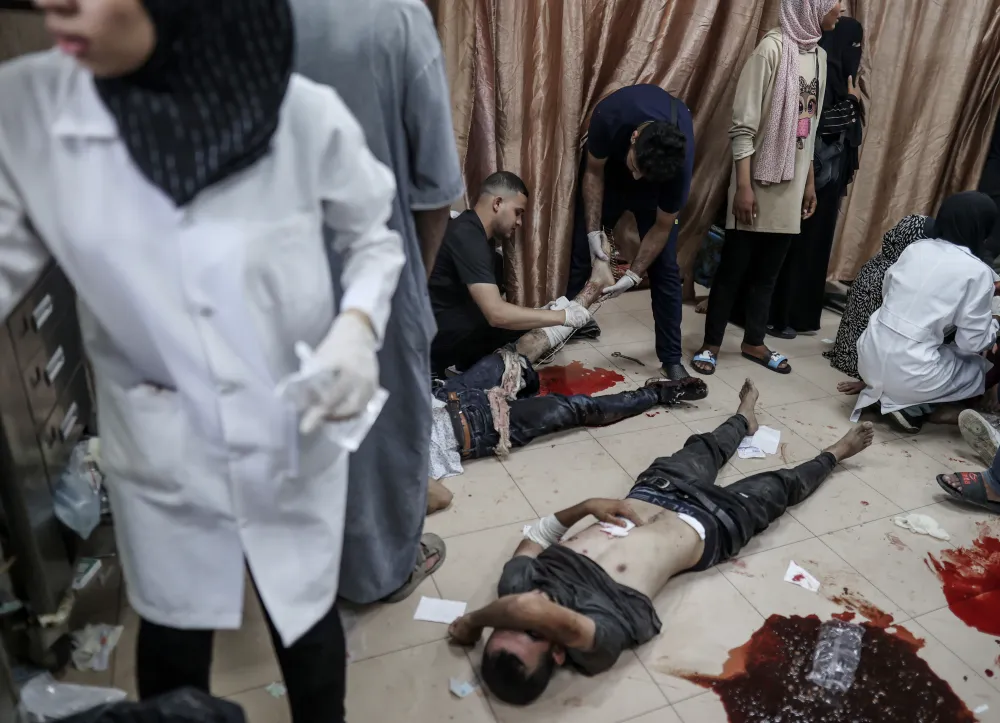Inside the Nuseirat Massacre: This Is the Carnage I Saw During Israel’s 4-Hostage Rescue
PALESTINE - ISRAEL, 17 Jun 2024
Shrouq Aila | The Intercept - TRANSCEND Media Service

A Palestinian girl walks over rubble in the aftermath of Israel’s raid on Nuseirat refugee camp in Gaza on 9 Jun 2024. Photo: Majdi Fathi/NurPhoto via Getty Images
Eyewitness: I was on the road to the camp when Israel launched its raid — and saw the aftermath in a nearby hospital.
10 Jun 2024 – Suhail Mutlaq Abu Nasser didn’t originally come from the Nuseirat refugee camp in the central Gaza Strip. But, by the time the Israeli military attacked the area on Saturday — part of a large-scale operation to rescue four Israeli hostages seized from a rave on October 7 — the camp was the closest thing Abu Nasser had to a home.
After initially settling in the area in November, Abu Nasser, 60, faced more displacements, but the tortuous journey brought him back to Nuseirat this spring. The house in Nuseirat he’d taken up had been bombed and was partially destroyed, but he reasoned it was better than the nylon tent he had stayed in down south in Rafah.
On Saturday, at around 11 a.m., Abu Nasser was standing by a window in the home when missiles began to rain down on the area. One struck just 20 meters away.
“The area turned to ashes,” Abu Nasser told me in a Sunday interview. “I couldn’t find my wife and started calling out to those around me to ensure they were still alive.”
“The street was filled with civilian body parts and many injuries bleeding out without ambulances being able to reach them.”
Driven outside by fear of his building being bombed, Abu Nasser was confronted by a massive Israeli attack unfolding around him. The streets were filled by a swarm of quadcopter drones equipped with small arms. Tank tracks could be heard nearby. U.S.-made Apache attack helicopters hovered. Nearby homes were hit with missiles.
“We heard people crying for help in the bombed houses,” Abu Nasser said. “They had martyrs and injuries, but we couldn’t help them.”
The scene was gruesome. “The street was filled with civilian body parts,” he said, “and many injuries bleeding out without ambulances being able to reach them.”
The sustained attack on Nuseirat lasted about 75 minutes.
“The operation ended, but we stayed in our places, afraid to move for a long time,” Abu Nasser recalled. “It was a horrific scene and a difficult time that I had never experienced in my life.”
“Why Did They Deserve This?”
As the Israeli forces withdrew with four hostages in tow, they left death and destruction in their wake. The authorities in Gaza announced that 274 people, including 64 children and 57 women, had been killed, with more than 400 injuries, and that 89 inhabited homes or residential buildings had been bombed during the raid.
A release from the Hamas government media office in Gaza said Israeli soldiers disguised themselves as displaced persons in carrying out what is being called the Nuseirat massacre.
The Washington Post verified two videos of a truck bearing the logo of a dishwashing soap being escorted out of Nuseirat by Israeli tanks — though whether the scene was before or after the attack was unclear. Another video posted online showed a Mercedes-Benz van with living items strapped to it — a “Grapes of Wrath”-like scene common in Gaza. An eyewitness told the Post that about 10 Israeli soldiers leapt out of the van, shooting the eyewitness’s brother. (A representative for Israel Defense Forces spokesperson Rear Adm. Daniel Hagari told The Intercept no civilian vehicles were used in the attack.)
“There is nothing, nothing at all that justifies what I saw today. Nothing.”
Al-Aqsa Martyrs Hospital in Deir al-Balah, which I visited on Saturday, was overflowing with casualties from Nuseirat. Ambulances continually arrived, and screams filled the air. Chaos reigned in the emergency room throughout the afternoon, said Karin Huster, a policy organizer and supervisor working at Al-Aqsa with Doctors Without Borders, according to a recording she sent from Gaza that was released by the medical aid group, known by its French initials MSF.
“There is nothing, nothing at all that justifies what I saw today,” Huster said. “Nothing.”
“These children — the 3-month-old, the 7-year-old, the 12-year-old who died — the 25-year-old man, the 78-year-old woman, who all have horrendous injuries,” she continued. “Why did they deserve this? And why is the world looking on in silence? To what level of horror do we need to go before we finally do something, before we finally tell Israel that this is not acceptable?”

A man holding a dead child killed during Israeli attacks surrounding its raid on Nuseirat refugee camp, in the Gaza Strip, on 8 Jun 2024.
Photo: Ali Jadallah/Anadolu via Getty Images
The Road to Nuseirat
I was on my way to Nuseirat when the Israeli military launched its attack.
The war has been turbulent for me. Like Abu Nasser, I’ve been displaced and relocated three times during the war. Most recently, in May, I arrived in Deir al-Balah, a city in central Gaza.
Like many others, I have lost loved ones and I have lost colleagues. One of the losses, my husband, was the epitome of both and much more. He was a partner in our production company, the father of my daughter, and the love of my life. He was killed by the Israelis in October, shielding me and our daughter when our home was struck by two rockets. I knew I had to go on, to keep telling stories.
And so it was on June 8 that I set out by car to make the roughly 4-mile trip from Deir al-Balah to Nuseirat to do an interview for a film we’re working on. The woman who was to be my interview subject lives in the camp.
As we were approaching Nuseirat, I felt a pang of uneasiness. I told the driver, “I feel uncomfortable going there and I’m thinking of canceling the trip.” Suddenly, everything escalated rapidly.
Through the car window, I saw four helicopter gunships flying low and firing continuously. Artillery shells were landing nearby, seemingly at random. The sounds of explosions were incessant.
We were contemplating whether to proceed or turn back when a missile targeted the house next to us, and shrapnel flew over our heads.
All I could think of in the moment was my little daughter. She had turned 1 within two weeks of her father’s killing. I wondered how she could possibly cope with losing her mother as well.
We headed back to Deir al-Balah and to Al-Aqsa Hospital.
“The Gamut of War Wounds”
Hospitals in the Gaza Strip have repeatedly faced attacks by the Israeli military, even as they sometimes served as shelters for displaced people. Health care facilities have come under sustained siege and faced repeated evacuation orders, with Israeli snipers picking people off outside as they tried to follow the commands.
Foreign doctors returning from aid missions to Gaza have reported unspeakable carnage. With military assaults and resources like fuel under strain, maternity wards have struggled to deliver and keep premature babies alive. And hundreds of health care workers have disappeared into Israeli detention.
Huster, the MSF aid worker at Al-Aqsa, said military activity in Deir al-Balah began around 11:30 a.m., according to the recording released by MSF.
“We started to hear really, really intense IDF activity, lots of bombardments, lots of shooting, helicopters,” she said in the recording. Soon, Huster said, the MSF workers heard a “huge blast right next to our office, which is not very far from Al-Aqsa Hospital.”
Huster said the MSF workers began preparing supplies and soon received a plea from the hospital director to come assist. In the early afternoon, after evaluating the security situation, they arrived at the hospital’s emergency room.
“It was, as usual, mayhem,” said Huster. “But it was compounded mayhem from the last four days: total chaos inside.”
The ER was “completely packed with patients on the floor coming from the bombings in Nuseirat” — there were hundreds of patients, she said.
“There were children everywhere, there were women, there were men,” Huster goes on in the recording. “We had the gamut of war wounds, trauma wounds, from amputations to eviscerations to trauma, to TBIs, traumatic brain injuries. Fractures, obviously, big burns.”
“Kids completely grey or white from the shock, burnt, screaming for their parents — many of them not screaming because they are in shock,” she continues.

Palestinians injured and killed in the violence surrounding Israel’s attack on Nuseirat refugee camp, shown at Al Aqsa Martyrs Hospital in Deir al-Balah, Gaza, on 8 Jun 2024. Photo: Ali Jadallah/Anadolu via Getty Images
At one point during my visit, a panic coursed through the media tent. Word had spread that the Israeli military called the hospital to warn that it was going to attack — specifically against the gathered journalists.
Whether it was a rumor or not — the IDF, in a statement to The Intercept, denied any hospital evacuation had been ordered — we decided to leave. Having fled to the hospital to escape the violence of the attack on Nuseirat, now I was fleeing from it.
The doctors and the families of the injured refused to leave. The attack never came.
“Waiting for Death”
Abu Nasser and his wife had been displaced the first time in November, from their home in Al-Saftawi, in Gaza’s north. They left on foot after their neighborhood was attacked by the Israeli military. Artillery shells and white phosphorus, an incendiary weapon whose use in civilian areas is banned, struck the area, and a shelter adjacent to their building was destroyed by an Israeli airstrike.
The journey along an Israeli-designated safe route took Abu Nasser and his wife 10 miles south, as the crow flies, to their first stint in Nuseirat. It was a new home, but only for a month and a half.
The displacement became an unwelcome pattern. In late December, Abu Nasser heeded Israel’s evacuation orders to again move south, this time ending up in Rafah with about 1.4 million other internally displaced Palestinians. They stayed in a tent in the Tel al-Sultan camp, not too far from Rafah’s center.
Five months later, when Rafah, in turn, was threatened by the Israeli army, Abu Nasser left again, returning to his bombed-out home in Nuseirat in May. The Tel al-Sultan camp in Rafah would become the site of what is now known as the “tent massacre” — named for the very shelters Abu Nasser left behind.
“We hid in a place the drones couldn’t reach.”
When the bombs struck near his place in Nuseirat on Saturday, and Abu Nasser and his wife fled to the street, he was surprised to find so many ways to die: tanks, attack helicopters, shells, missiles, and, picking people off on the street, the drones with small arms attached.
“People were running before our eyes, fleeing from the drones,” Abu Nasser said. “And we hid in a place the drones couldn’t reach.”
They stayed hidden behind the stairs for more than an hour, until the attack subsided.
“We were waiting for death,” Abu Nasser told me, “expecting the house to be bombed over our heads.”
________________________________________________
Sharif Abdel Kouddous contributed reporting to this story.
Go to Original – theintercept.com
Tags: Anglo America, Colonialism, Crimes against Humanity, Ecocide, Ethnic Cleansing, Famine, Gaza, Genocide, Genocide Convention, Hamas, Hunger, International Court of Justice ICJ, International Criminal Court ICC, Israel, Israeli Apartheid, Israeli occupation, Massacre, Palestine, Protests, Rafah, Students Anti-Genocide Gaza, USA, United Nations, War crimes, West Bank, Zionism
Join the BDS-BOYCOTT, DIVESTMENT, SANCTIONS campaign to protest the Israeli barbaric siege of Gaza, illegal occupation of the Palestine nation’s territory, the apartheid wall, its inhuman and degrading treatment of the Palestinian people, and the more than 7,000 Palestinian men, women, elderly and children arbitrarily locked up in Israeli prisons.
DON’T BUY PRODUCTS WHOSE BARCODE STARTS WITH 729, which indicates that it is produced in Israel. DO YOUR PART! MAKE A DIFFERENCE!
7 2 9: BOYCOTT FOR JUSTICE!
DISCLAIMER: The statements, views and opinions expressed in pieces republished here are solely those of the authors and do not necessarily represent those of TMS. In accordance with title 17 U.S.C. section 107, this material is distributed without profit to those who have expressed a prior interest in receiving the included information for research and educational purposes. TMS has no affiliation whatsoever with the originator of this article nor is TMS endorsed or sponsored by the originator. “GO TO ORIGINAL” links are provided as a convenience to our readers and allow for verification of authenticity. However, as originating pages are often updated by their originating host sites, the versions posted may not match the versions our readers view when clicking the “GO TO ORIGINAL” links. This site contains copyrighted material the use of which has not always been specifically authorized by the copyright owner. We are making such material available in our efforts to advance understanding of environmental, political, human rights, economic, democracy, scientific, and social justice issues, etc. We believe this constitutes a ‘fair use’ of any such copyrighted material as provided for in section 107 of the US Copyright Law. In accordance with Title 17 U.S.C. Section 107, the material on this site is distributed without profit to those who have expressed a prior interest in receiving the included information for research and educational purposes. For more information go to: http://www.law.cornell.edu/uscode/17/107.shtml. If you wish to use copyrighted material from this site for purposes of your own that go beyond ‘fair use’, you must obtain permission from the copyright owner.
Join the discussion!
We welcome debate and dissent, but personal — ad hominem — attacks (on authors, other users or any individual), abuse and defamatory language will not be tolerated. Nor will we tolerate attempts to deliberately disrupt discussions. We aim to maintain an inviting space to focus on intelligent interactions and debates.
Read more
Click here to go to the current weekly digest or pick another article:
PALESTINE - ISRAEL:
